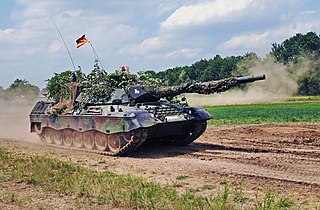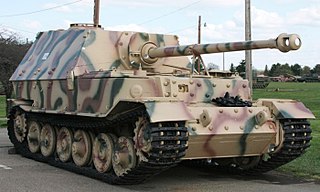
The Kampfpanzer Leopard is a main battle tank designed by Porsche and manufactured by Krauss-Maffei in West Germany, first entering service in 1965. Developed in an era when HEAT warheads were thought to make conventional heavy armour of limited value, the Leopard design focused on effective firepower and mobility instead of heavy protection. It featured moderate armour, only effective against low caliber autocannons and heavy machine guns, giving it a high power-to-weight ratio. This, coupled with a modern suspension and drivetrain, gave the Leopard superior mobility and cross-country performance compared to most other main battle tanks of the era, only being rivaled by the French AMX-30 and Swedish Strv 103. The main armament of the Leopard consisted of a German license-built version of the British Royal Ordnance L7 105 mm rifled gun, one of the most effective and widespread tank guns of the era.

Elefant was a heavy tank destroyer used by German Panzerjäger during World War II. Ninety-one units were built in 1943 under the name Ferdinand using VK 45.01 (P) tank hulls which had been produced for the Tiger I tank before the competing Henschel design had been selected.

The M113 is a fully tracked armored personnel carrier (APC) that was developed and produced by the FMC Corporation. The M113 was sent to United States Army Europe in 1961 to replace the mechanized infantry's M59 APCs. The M113 was first used in combat in April 1962 after the United States provided the South Vietnamese army (ARVN) with heavy weaponry such as the M113, under the Military Assistance Command, Vietnam (MACV) program. Eventually, the M113 was the most widely used armored vehicle of the U.S. Army in the Vietnam War and was used to break through heavy thickets in the midst of the jungle to attack and overrun enemy positions. It was largely known as an "APC" or an "ACAV" by the allied forces.

The Mowag Piranha is a family of armoured fighting vehicles designed by the Swiss company Mowag.

The Leopard 2 is a third generation German main battle tank (MBT). Developed by Krauss-Maffei in the 1970s, the tank entered service in 1979 and replaced the earlier Leopard 1 as the main battle tank of the West German army. Various iterations of the Leopard 2 continue to be operated by the armed forces of Germany, as well as 13 other European countries, and several non-European countries, including Canada, Chile, Indonesia, and Singapore. Some operating countries have licensed the Leopard 2 design for local production and domestic development.

The Boxer is a multirole armoured fighting vehicle designed by an international consortium to accomplish a number of operations through the use of installable mission modules. The governments participating in the Boxer programme have changed as the programme has developed. The Boxer vehicle is produced by the ARTEC GmbH industrial group, and the programme is being managed by OCCAR. ARTEC GmbH is based in Munich; its parent companies are Krauss-Maffei Wegmann GmbH and Rheinmetall Military Vehicles GmbH on the German side, and Rheinmetall Defence Nederland B.V. for the Netherlands. Overall, Rheinmetall has a 64% stake in the joint venture.

The PT-91 Twardy is a Polish main battle tank. A development of the T-72M1, it entered service in 1995. The PT-91 was designed at the OBRUM and is produced by the Bumar Łabędy company, part of the Bumar Group, a Polish technical military consortium. Changes from the T-72M include a new dual-axis stabilized fire-control system, reactive armour, a more powerful engine, transmission and new automatic loader.

The Schützenpanzer Marder 1 is a tracked German infantry fighting vehicle designed for use with the West German Panzergrenadiere units, mechanized infantry specialized for IFV combat. It has been operated by the German Army as the main Panzergrenadiere IFV since the 1970s through to the present day. Developed as part of the rebuilding of West Germany's armoured fighting vehicle industry, the Marder has proven to be a successful and solid infantry fighting vehicle design.

The Flugabwehrkanonenpanzer Gepard is an all-weather-capable German self-propelled anti-aircraft gun (SPAAG) based on the hull of the Leopard 1. It was developed in the 1960s, fielded in the 1970s, and has been upgraded several times with the latest electronics. It has been a cornerstone of the air defence of the German Army (Bundeswehr) and a number of other NATO countries.

The MG 3 is a German general-purpose machine gun chambered for the 7.62×51mm NATO cartridge. The weapon's design is derived from the World War II era MG 42 that fired the 7.92×57mm Mauser round.

An armoured recovery vehicle (ARV) is typically a powerful tank or armoured personnel carrier (APC) chassis modified for use during combat for military vehicle recovery (towing) or repair of battle-damaged, stuck, and/or inoperable armoured fighting vehicles, such as tanks and armoured personnel carriers. Most ARVs have motorized tracks, like a tank or bulldozer, enabling the ARV to operate on uneven ground. The term "Armoured Repair and Recovery Vehicle" (ARRV) is also used.

The AIFV is a US tracked light armored vehicle that serves as an infantry fighting vehicle (IFV) in the armies of several countries. It is a development of the M113A1 armored personnel carrier.

The M88 Recovery Vehicle is one of the largest armored recovery vehicles (ARV) in use by United States Armed Forces. There are three variants, the M88, the M88A1, and the M88A2 HERCULES. The M88 series has seen action in the Vietnam War, the Persian Gulf War, the Iraq War, and the War in Afghanistan, and to a lesser extent during the Kosovo War, where they were deployed to help recover heavy armored vehicles of the Allied ground units. As of 2000, the M88A2 replacement cost was around US$2,050,000.

The M74 tank recovery vehicle (M74) was an engineer vehicle used by the U.S. Army in the 1950s. It was designed to cope with the heavier weights of the M26 Pershing and M47 Patton. It could also be suitable for light dozing, since it had a hydraulic, front-mounted spade. 1126 were produced by Bowen-McLaughlin-York by converting M4A3 Sherman tanks starting in 1954. From 1956, 60 M32B3A1s were converted by Rock Island Arsenal until 1958.
The Flensburger Fahrzeugbau Gesellschaft mbH (FFG) is a medium-sized company based in Flensburg, Germany. It operates in the military vehicle manufacturing, maintenance, and upgrade business sectors.

Tanks of the Ukrainian Army have been used within the military, with their usage and origin after the Cold War; and the modern era. This includes tanks manufactured in Ukraine, leftover Soviet tanks in the Ukrainian Ground Forces today as well as designs imported from other countries and tanks captured in the Russo-Ukrainian War.

















